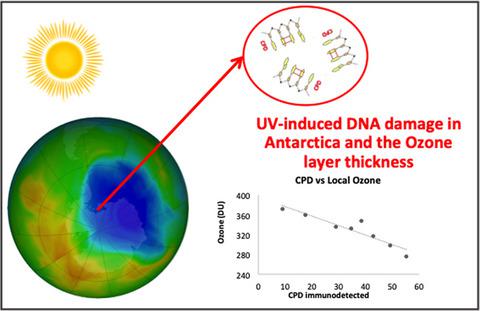当前位置:
X-MOL 学术
›
Photochem. Photobiol.
›
论文详情
Our official English website, www.x-mol.net, welcomes your
feedback! (Note: you will need to create a separate account there.)
DNA Damage Induced by Late Spring Sunlight in Antarctica
Photochemistry and Photobiology ( IF 2.6 ) Pub Date : 2020-07-24 , DOI: 10.1111/php.13307 Fabiana Fuentes-León 1, 2 , Andressa Peres de Oliveira 2 , Nathalia Quintero-Ruiz 2 , Veridiana Munford 2 , Gustavo Satoru Kajitani 2 , Antônio Coimbra Brum 3 , André Passaglia Schuch 4 , Pio Colepicolo 5 , Angel Sánchez-Lamar 1 , Carlos Frederico Martins Menck 2
Photochemistry and Photobiology ( IF 2.6 ) Pub Date : 2020-07-24 , DOI: 10.1111/php.13307 Fabiana Fuentes-León 1, 2 , Andressa Peres de Oliveira 2 , Nathalia Quintero-Ruiz 2 , Veridiana Munford 2 , Gustavo Satoru Kajitani 2 , Antônio Coimbra Brum 3 , André Passaglia Schuch 4 , Pio Colepicolo 5 , Angel Sánchez-Lamar 1 , Carlos Frederico Martins Menck 2
Affiliation

|
Sunlight ultraviolet (UV) radiation constitutes an important environmental genotoxic agent that organisms are exposed to, as it can damage DNA directly, generating pyrimidine dimers, and indirectly, generating oxidized bases and single‐strand breaks (SSBs). These lesions can lead to mutations, triggering skin and eye disorders, including carcinogenesis and photoaging. Stratospheric ozone layer depletion, particularly in the Antarctic continent, predicts an uncertain scenario of UV incidence on the Earth in the next decades. This research evaluates the DNA damage caused by environmental exposure to late spring sunlight in the Antarctic Peninsula, where the ozone layer hole is more pronounced. These experiments were performed at the Brazilian Comandante Ferraz Antarctic Station, at King’s George Island, South Shetlands Islands. For comparison, tropical regions were also analyzed. Samples of plasmid DNA were exposed to sunlight. Cyclobutane pyrimidine dimers (CPDs), oxidized base damage and SSBs were detected using specific enzymes. In addition, an immunological approach was used to detect CPDs. The results reveal high levels of DNA damage induced by exposure under the Antarctic sunlight, inversely correlated with ozone layer thickness, confirming the high impact of ozone layer depletion on the DNA damaging action of sunlight in Antarctica.
中文翻译:

南极晚春阳光引起的DNA损伤
阳光紫外线 (UV) 辐射是生物体暴露的一种重要的环境遗传毒性剂,因为它可以直接损伤 DNA,产生嘧啶二聚体,并间接地产生氧化碱基和单链断裂 (SSB)。这些病变会导致突变,引发皮肤和眼部疾病,包括致癌作用和光老化。平流层臭氧层消耗,特别是在南极大陆,预示着未来几十年地球上紫外线发生率的不确定性情景。这项研究评估了南极半岛因环境暴露于晚春阳光而造成的 DNA 损伤,这里的臭氧层空洞更为明显。这些实验是在位于南设得兰群岛国王乔治岛的巴西 Comandante Ferraz 南极站进行的。为了比较,还分析了热带地区。将质粒 DNA 样品暴露在阳光下。使用特定酶检测环丁烷嘧啶二聚体 (CPD)、氧化碱损伤和 SSB。此外,还使用免疫学方法检测 CPD。结果表明,暴露在南极阳光下会引起高水平的 DNA 损伤,与臭氧层厚度成反比,证实了臭氧层消耗对南极阳光 DNA 损伤作用的高度影响。
更新日期:2020-07-24
中文翻译:

南极晚春阳光引起的DNA损伤
阳光紫外线 (UV) 辐射是生物体暴露的一种重要的环境遗传毒性剂,因为它可以直接损伤 DNA,产生嘧啶二聚体,并间接地产生氧化碱基和单链断裂 (SSB)。这些病变会导致突变,引发皮肤和眼部疾病,包括致癌作用和光老化。平流层臭氧层消耗,特别是在南极大陆,预示着未来几十年地球上紫外线发生率的不确定性情景。这项研究评估了南极半岛因环境暴露于晚春阳光而造成的 DNA 损伤,这里的臭氧层空洞更为明显。这些实验是在位于南设得兰群岛国王乔治岛的巴西 Comandante Ferraz 南极站进行的。为了比较,还分析了热带地区。将质粒 DNA 样品暴露在阳光下。使用特定酶检测环丁烷嘧啶二聚体 (CPD)、氧化碱损伤和 SSB。此外,还使用免疫学方法检测 CPD。结果表明,暴露在南极阳光下会引起高水平的 DNA 损伤,与臭氧层厚度成反比,证实了臭氧层消耗对南极阳光 DNA 损伤作用的高度影响。











































 京公网安备 11010802027423号
京公网安备 11010802027423号